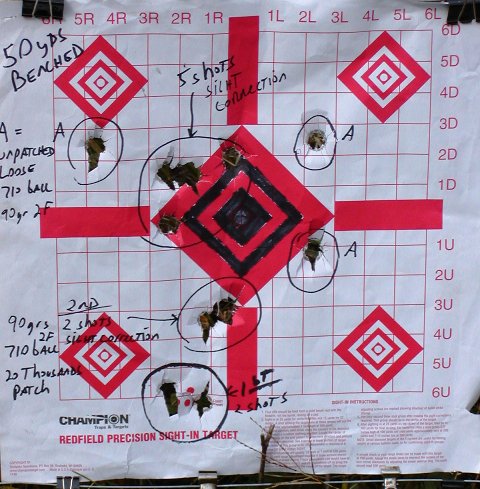- Joined
- Nov 26, 2005
- Messages
- 5,274
- Reaction score
- 11,202
Hi,
Well, she's a shooter. After getting some idea of powder charge and patch combination shooting at a dot on cardboard, I put up a real target and fiddled a little with the front sight. Every shot was from a bench at 50 yards. I used 90grs 2F powder, 0.020" patches lubed with ballistol and water, and 0.710" round balls. I also shot 3 rounds with loose ball and no patch. I did not adjust windage but filed down the front sight just a little and changed my point of aim from 6 o'clock hold to center. I won't do more because the sight picture may be different for the owner and how the stock fits him will differ from me. The irony is that the gun will rarely be used with live ammunition since the owner will use it mainly for re-enactments. I had to drill the vent hole out to 5/64" to assure reliable ignition because the barrel is very thick at the breech. It is very comfortable to shoot and holds well. It has considerably more drop in the heel than a Brown Bess so it is a much better shooter.
dave

Well, she's a shooter. After getting some idea of powder charge and patch combination shooting at a dot on cardboard, I put up a real target and fiddled a little with the front sight. Every shot was from a bench at 50 yards. I used 90grs 2F powder, 0.020" patches lubed with ballistol and water, and 0.710" round balls. I also shot 3 rounds with loose ball and no patch. I did not adjust windage but filed down the front sight just a little and changed my point of aim from 6 o'clock hold to center. I won't do more because the sight picture may be different for the owner and how the stock fits him will differ from me. The irony is that the gun will rarely be used with live ammunition since the owner will use it mainly for re-enactments. I had to drill the vent hole out to 5/64" to assure reliable ignition because the barrel is very thick at the breech. It is very comfortable to shoot and holds well. It has considerably more drop in the heel than a Brown Bess so it is a much better shooter.
dave





 I was looking at another pic and got this one by mistake, but looking at it there does seem to be militia markings on the butt stock too! Cool!
I was looking at another pic and got this one by mistake, but looking at it there does seem to be militia markings on the butt stock too! Cool!